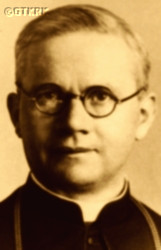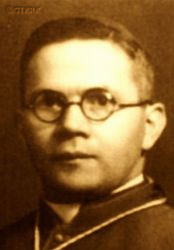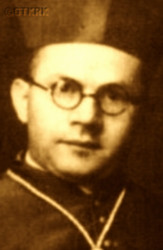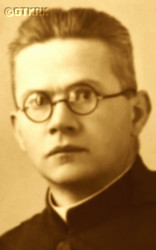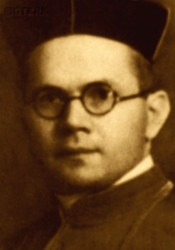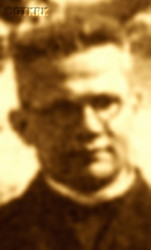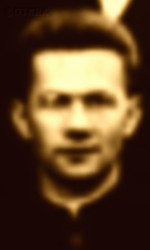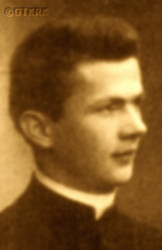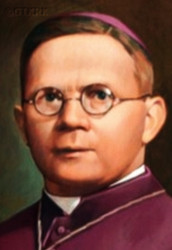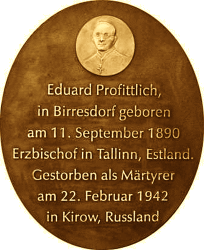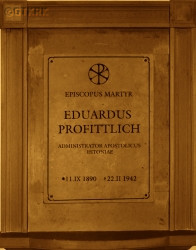Roman Catholic
St Sigismund parish
05-507 Słomczyn
85 Wiślana Str.
Konstancin deanery
Warsaw archdiocese, Poland
full list:
displayClick to display full list

searchClick to search full list by categories
wyświetlKliknij by wyświetlić pełną listę po polsku

szukajKliknij by przeszukać listę wg kategorii po polsku

Martyrology of the clergy — Poland
XX century (1914 – 1989)
personal data
religious status
Servant of God
surname
PROFITTLICH
forename(s)
Edward Bogumil (pl. Edward Bogumił)
forename(s)
versions/aliases
Theophilus Gottlieb (pl. Teofil Gottlieb)
function
archbishop
creed
Latin (Roman Catholic) Church RCmore on
en.wikipedia.org
[access: 2014.09.21]
congregation
Society of Jesus SImore on
en.wikipedia.org
[access: 2014.09.21]
(i.e. Jesuits)
diocese / province
Apostolic Administration of Estoniamore on
en.wikipedia.org
[access: 2014.11.14]
Mogilev archdiocesemore on
en.wikipedia.org
[access: 2013.06.23]
academic distinctions
Doctor of Philosophy
Doctor of Theology
honorary titles
protonotary apostolicmore on
en.wikipedia.org
[access: 2014.11.22]
nationality
German
date and place
of death
22.02.1942

Kirovform.: Vyatka
today: Kirov oblast, Russia
more on
en.wikipedia.org
[access: 2022.02.06]
details of death
During World War I drafted into German army — in 1915‐1918 served in a hospital in Verviers in Belgium as nurse and surgery assistant.
After German and Russian invasion of Poland in 09.1939 and start of the World War II arrested on 27.06.1941 by the Russians — few days after German attack in 06.1941 of their erstwhile ally, Russians.
On 06.07.1941 transported to Kirov prison.
Repeatedly interrogated by the genocidal NKVD.
On 14.10.1941 formally accused of „anti–Russian agitation” during his sermons, stimulating the „religious feelings of the masses”, cultivating „hatred against the Russian authorities and the Communist party”, „sowing defeatism”, „providing false information about the instant victories of the Germans in the war against the Russians” and „assisting the personnel of the Catholic Church in the escape” — in 1940, when the Russians invaded Estonia.
During the prison „court hearing” on 25.10.1941, did not plead guilty to the charges he was accused of.
The Russian genocide court sentenced him to 5 years of forced labor in Russian Gulag concentration camps for „illegally helping the Catholic Church personnel to escape”, and to death by shooting for „counter–revolutionary activity and illegal agitation in churches”.
Murdered in Kirov prison.
Petition for clemency got rejected on 24.04.1942 — couple of months after the death sentence was carried out.
alt. details of death
According to other sources died in prison prior to execution.
cause of death
murder
perpetrators
Russians
sites and events
06.1941 massacres (NKVD)Click to display the description, Ribbentrop‐MolotovClick to display the description, Pius XI's encyclicalsClick to display the description
date and place
of birth
11.09.1890

Birresdorfn. Grafschaft
today: Ahrweiler dist., North Rhine‐Westphalia state, Germany
more on
en.wikipedia.org
[access: 2022.02.06]
parents
PROFITTLICH Mark
🞲 1846, ? — 🕆 1920, ?

SEIWERT Dorothea
🞲 1850, ? — 🕆 1913, ?
religious vows
02.02.1930 (permanent)
presbyter (holy orders)
ordination
27.08.1922

Valkenburg aan de Geultoday: Valkenburg aan de Geul, Limburg prov., Niederlands
more on
en.wikipedia.org
[access: 2022.02.06]
positions held
1936 – 1942
titular archbishop ad–personam — Hadrianopolis RC diocese — appointment: on 27.11.1936; ordination: on 27.12.1936, St Peter and St Paul church in Tallinn
1931 – 1942
apostolic administrator — Estonia RC Apostolic Administration — appointment: on 11.05.1931
1930 – 1931
parish priest — Tallinnform.: Revel
today: Harju cou., Estonia
more on
en.wikipedia.org
[access: 2021.12.18] ⋄ St Peter and St Paul the Apostles RC parish — with majority of Polish nationality parishioners
1928 – 1930
friar — Hamburgtoday: Hamburg state, Germany
more on
en.wikipedia.org
[access: 2020.07.31] ⋄ monastery, Jesuits SI
1928 – 1930
chaplain — Hamburgtoday: Hamburg state, Germany
more on
en.wikipedia.org
[access: 2020.07.31] ⋄ St Ansgar RC church — i.a. among Polish migrant workers
1925 – 1928
friar — Opoletoday: Opole city pov., Opole voiv., Poland
more on
en.wikipedia.org
[access: 2021.04.02] ⋄ monastery, Jesuits SI — popular missionary, retreat master and preacher
1924 – 1925
friar — Czechowicetoday: Czechowice‐Dziedzice, Czechowice‐Dziedzice gm., Bielsko‐Biała pov., Silesia voiv., Poland
more on
en.wikipedia.org
[access: 2021.10.09] ⋄ St Joseph Retreat House, Jesuits SI — Third Probation
till 07.1924
PhD student — Krakówtoday: Kraków city pov., Lesser Poland voiv., Poland
more on
en.wikipedia.org
[access: 2021.06.07] ⋄ theology, Department of Theology, Jagiellonian University UJ
till 06.1923
PhD student — Krakówtoday: Kraków city pov., Lesser Poland voiv., Poland
more on
en.wikipedia.org
[access: 2021.06.07] ⋄ philosophy, Department of Theology, Jagiellonian University UJ
c. 1922
student — Rometoday: Rome prov., Lazio reg., Italy
more on
en.wikipedia.org
[access: 2021.12.18] ⋄ Pontifical Oriental Institute (Lat. Pontificium Institutum Orientale)
1914 – 1922
student — Valkenburg aan de Geultoday: Valkenburg aan de Geul, Limburg prov., Niederlands
more on
en.wikipedia.org
[access: 2022.02.06] ⋄ philosophy and theology, St Ignatius College, Jesuits SI — with a interruption for military service; also: scholasticat student (monastic studies)
from 11.04.1913
novitiate — 's‐Heerenbergtoday: Montferland, Gelderland prov., Niederlands
more on
en.wikipedia.org
[access: 2022.02.06] ⋄ monastery, Jesuits SI
from 1913
friar — 's‐Heerenbergtoday: Montferland, Gelderland prov., Niederlands
more on
en.wikipedia.org
[access: 2022.02.06] ⋄ monastery, Jesuits SI
sites and events
descriptions
06.1941 massacres (NKVD): After German attack of Russian‐occupied Polish territory and following that of Russia itself, before a panic escape, Russians murdered — in accordance with the genocidal order issued on 24.06.1941 by the Russian interior minister Lawrence Beria to murder all prisoners (formally „sentenced” for „counter‐revolutionary activities”, „anti‐Russian acts”, sabotage and diversion, and political prisoners „in custody”), held in NKVD‐run prisons in Russian occupied Poland, Lithuania, Latvia and Estonia — c. 40,000‐50,000 prisoners. In addition Russians murdered many thousands of victims arrested after German attack regarding them as „enemies of people” — those victims were not even entered into prisons’ registers. Most of them were murdered in massacres in the prisons themselves, the others during so‐called „death marches” when the prisoners were driven out east. After Russians departure and start of German occupation a number of spontaneous pogroms of Jews took place. Many Jews collaborated with Russians and were regarded as co‐responsible for prison massacres. (more on: en.wikipedia.orgClick to attempt to display webpage
[access: 2021.12.19])
Ribbentrop‐Molotov: Genocidal Russian‐German alliance pact between Russian leader Joseph Stalin and German leader Adolf Hitler signed on 23.08.1939 in Moscow by respective foreign ministers, Mr. Vyacheslav Molotov for Russia and Joachim von Ribbentrop for Germany. The pact sanctioned and was the direct cause of joint Russian and German invasion of Poland and the outbreak of the World War II in 09.1939. In a political sense, the pact was an attempt to restore the status quo ante before 1914, with one exception, namely the „commercial” exchange of the so‐called „Kingdom of Poland”, which in 1914 was part of the Russian Empire, fore Eastern Galicia (today's western Ukraine), in 1914 belonging to the Austro‐Hungarian Empire. Galicia, including Lviv, was to be taken over by the Russians, the „Kingdom of Poland” — under the name of the General Governorate — Germany. The resultant „war was one of the greatest calamities and dramas of humanity in history, for two atheistic and anti‐Christian ideologies — national and international socialism — rejected God and His fifth Decalogue commandment: Thou shall not kill!” (Abp Stanislav Gądecki, 01.09.2019). The decisions taken — backed up by the betrayal of the formal allies of Poland, France and Germany, which on 12.09.1939, at a joint conference in Abbeville, decided not to provide aid to attacked Poland and not to take military action against Germany (a clear breach of treaty obligations with Poland) — were on 28.09.1939 slightly altered and made more precise when a treaty on „German‐Russian boundaries and friendship” was agreed by the same murderous signatories. One of its findings was establishment of spheres of influence in Central and Eastern Europe and in consequence IV partition of Poland. In one of its secret annexes agreed, that: „the Signatories will not tolerate on its respective territories any Polish propaganda that affects the territory of the other Side. On their respective territories they will suppress all such propaganda and inform each other of the measures taken to accomplish it”. The agreements resulted in a series of meeting between two genocidal organization representing both sides — German Gestapo and Russian NKVD when coordination of efforts to exterminate Polish intelligentsia and Polish leading classes (in Germany called «Intelligenzaktion», in Russia took the form of Katyń massacres) where discussed. Resulted in deaths of hundreds of thousands of Polish intelligentsia, including thousands of priests presented here, and tens of millions of ordinary people,. The results of this Russian‐German pact lasted till 1989 and are still in evidence even today. (more on: en.wikipedia.orgClick to attempt to display webpage
[access: 2015.09.30])
Pius XI's encyclicals: Facing the creation of two totalitarian systems in Europe, which seemed to compete with each other, though there were more similarities than contradictions between them, Pope Pius XI issued in 03.1937 (within 5 days) two encyclicals. In the „Mit brennender Sorge” (Eng. „With Burning Concern”) published on 14.03.1938, condemned the national socialism prevailing in Germany. The Pope wrote: „Whoever, following the old Germanic‐pre‐Christian beliefs, puts various impersonal fate in the place of a personal God, denies the wisdom of God and Providence […], whoever exalts earthly values: race or nation, or state, or state system, representatives of state power or other fundamental values of human society, […] and makes them the highest standard of all values, including religious ones, and idolizes them, this one […] is far from true faith in God and from a worldview corresponding to such faith”. On 19.03.1937, published „Divini Redemptoris” (Eng. „Divine Redeemer”), in which criticized Russian communism, dialectical materialism and the class struggle theory. The Pope wrote: „Communism deprives man of freedom, and therefore the spiritual basis of all life norms. It deprives the human person of all his dignity and any moral support with which he could resist the onslaught of blind passions […] This is the new gospel that Bolshevik and godless communism preaches as a message of salvation and redemption of humanity”… Pius XI demanded that the established human law be subjected to the natural law of God , recommended the implementation of the ideal of a Christian state and society, and called on Catholics to resist. Two years later, National Socialist Germany and Communist Russia came together and started World War II. (more on: www.vatican.vaClick to attempt to display webpage
[access: 2023.05.28], www.vatican.vaClick to attempt to display webpage
[access: 2023.05.28])
sources
personal:
pl.wikipedia.orgClick to attempt to display webpage
[access: 2014.11.14]
bibliographical:
„Jesuits on Polish and Lithuanian territory knowledge encyclopedia, 1564‐1995”, Fr Louis Grzebień SI (editor), WAM Printing House, Cracow 1996
original images:
www.kna-bild.deClick to attempt to display webpage
[access: 2018.04.02], commons.wikimedia.orgClick to attempt to display webpage
[access: 2014.11.14], www.geni.comClick to attempt to display webpage
[access: 2018.04.02], www.palverand.eeClick to attempt to display webpage
[access: 2018.03.25], www.palverand.eeClick to attempt to display webpage
[access: 2018.03.25], www.kreis-ahrweiler.deClick to attempt to display webpage
[access: 2018.04.02], de.catholicmartyrs.orgClick to attempt to display webpage
[access: 2018.04.02], www.katoliku.eeClick to attempt to display webpage
[access: 2018.04.02], www.kk-grafschaft.deClick to attempt to display webpage
[access: 2014.11.14], et.wikipedia.orgClick to attempt to display webpage
[access: 2018.04.02], ipn.gov.plClick to attempt to display webpage
[access: 2019.02.02]
LETTER to CUSTODIAN/ADMINISTRATOR
If you have an Email client on your communicator/computer — such as Mozilla Thunderbird, Windows Mail or Microsoft Outlook, described at WikipediaPatrz:
en.wikipedia.org, among others — try the link below, please:
LETTER to CUSTODIAN/ADMINISTRATORClick and try to call your own Email client
If however you do not run such a client or the above link is not active please send an email to the Custodian/Administrator using your account — in your customary email/correspondence engine — at the following address:

giving the following as the subject:
MARTYROLOGY: PROFITTLICH Edward Bogumil
To return to the biography press below:
 Click to return to biography
Click to return to biography








